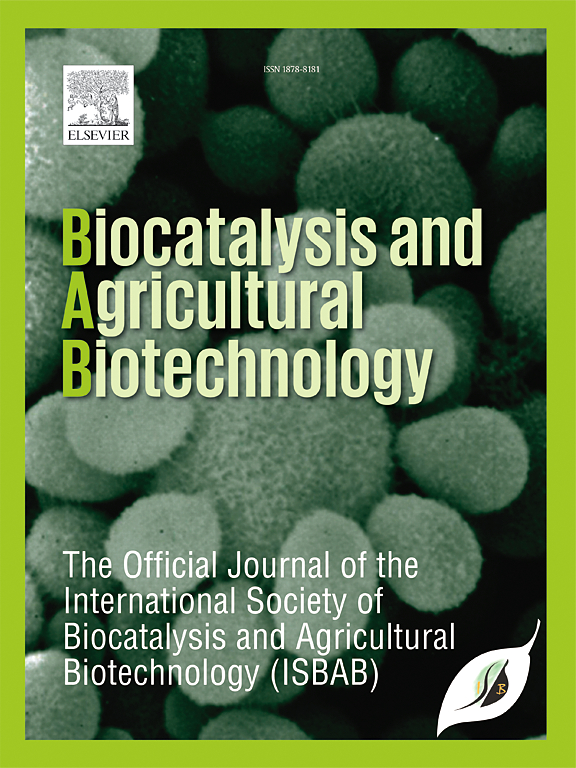Physiological and biochemical responses of mung bean exposed to different concentrations of nano-CeO2
IF 3.8
Q2 BIOTECHNOLOGY & APPLIED MICROBIOLOGY
引用次数: 0
Abstract
Cerium oxide nanoparticles (CeO2-NPs) are widely used across sectors, including agriculture. However, their overuse has led to environmental dispersion, raising concerns about adverse effects on crops and human health via the food chain. This study investigates the physiological, biochemical, and ultrastructural effects of CeO2-NPs on mung bean (Vigna radiata L.) under greenhouse and semi-natural conditions. The results reveal both beneficial and harmful impacts, highlighting the need for caution in their application. Foliar spraying of CeO2-NPs elicited dose-dependent responses. In the greenhouse, 500 mg L−1 significantly increased superoxide dismutase (720 %) and proline accumulation (223 %). Under semi-natural conditions, the same dose enhanced shoot dry weight by 27.1 % compared to the control (p ≤ 0.05). In contrast, exposure to 1000 mg L−1 elevated hydrogen peroxide (50 %) and lipid peroxidation (137 %), reduced chlorophyll (20 %), disrupted cellular ultrastructure, and impaired nitrogen fixation, leading to chlorosis and necrosis. This dose also caused significant reductions in dry weight (18.4 % in greenhouse, 25.4 % in semi-natural) and grain yield (55.9 %) (p ≤ 0.05). Root nodulation was significantly reduced at all tested concentrations (250, 500, 1000 mg L−1), suggesting a toxicity threshold below 250 mg L−1. Seed quality was adversely affected, as shown by decreased iron and zinc levels and increased cerium accumulation (p ≤ 0.05). These findings offer essential insights into the potential risks of CeO2-NPs in leguminous crops, with implications for food safety and sustainable agriculture.

不同浓度纳米氧化铈对绿豆生理生化的影响
氧化铈纳米颗粒(CeO2-NPs)广泛应用于包括农业在内的各个部门。然而,它们的过度使用导致环境分散,引起人们对通过食物链对作物和人类健康产生不利影响的担忧。研究了温室和半自然条件下CeO2-NPs对绿豆生理生化和超微结构的影响。结果揭示了有益和有害的影响,强调了在应用它们时需要谨慎。叶面喷施CeO2-NPs引起剂量依赖性反应。在温室中,500 mg L−1显著提高了超氧化物歧化酶(720%)和脯氨酸积累(223%)。在半自然条件下,同剂量处理使茎干重较对照提高27.1% (p≤0.05)。相比之下,暴露于1000 mg L−1时,过氧化氢升高(50%),脂质过氧化(137%),叶绿素降低(20%),细胞超微结构被破坏,固氮功能受损,导致黄化和坏死。该剂量还显著降低了干重(温室18.4%,半天然25.4%)和籽粒产量(55.9%)(p≤0.05)。在所有测试浓度(250、500、1000 mg L−1)下,根结瘤显著减少,表明毒性阈值低于250 mg L−1。铁和锌水平降低,铈积累量增加,对种子品质产生不利影响(p≤0.05)。这些发现对豆科作物中CeO2-NPs的潜在风险提供了重要见解,对食品安全和可持续农业具有重要意义。
本文章由计算机程序翻译,如有差异,请以英文原文为准。
求助全文
约1分钟内获得全文
求助全文
来源期刊

Biocatalysis and agricultural biotechnology
Agricultural and Biological Sciences-Agronomy and Crop Science
CiteScore
7.70
自引率
2.50%
发文量
308
审稿时长
48 days
期刊介绍:
Biocatalysis and Agricultural Biotechnology is the official journal of the International Society of Biocatalysis and Agricultural Biotechnology (ISBAB). The journal publishes high quality articles especially in the science and technology of biocatalysis, bioprocesses, agricultural biotechnology, biomedical biotechnology, and, if appropriate, from other related areas of biotechnology. The journal will publish peer-reviewed basic and applied research papers, authoritative reviews, and feature articles. The scope of the journal encompasses the research, industrial, and commercial aspects of biotechnology, including the areas of: biocatalysis; bioprocesses; food and agriculture; genetic engineering; molecular biology; healthcare and pharmaceuticals; biofuels; genomics; nanotechnology; environment and biodiversity; and bioremediation.
 求助内容:
求助内容: 应助结果提醒方式:
应助结果提醒方式:


